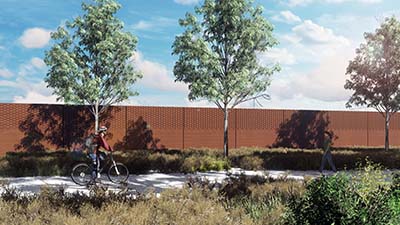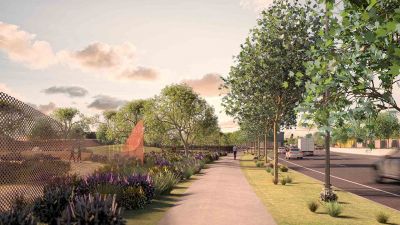Construction
Construction of the T2D Project will be broadly undertaken from south to north, beginning with the Southern Tunnels before moving onto the open motorway section, then the Northern Tunnels.
Tunnel sections will transition to the open motorway and the existing road network via cut and cover tunnels or trough structures. Construction of the tunnel and open motorway elements will be complex and requires a considered approach.
- Summary
Download a summary of Construction in PDF format
Construction methodology
Construction of the project will occur in two stages, beginning with the Southern Tunnels section before moving onto the Northern Tunnels section.
Southern package
- construction of Southern Tunnels by tunnel boring machines (TBM)
- construction of cut and cover tunnels at each end of the TBM tunnels
- construction of cross passages and drainage sumps
- construction of dive structures and lowered and surface motorway
- construction of surface connections, bridgeworks and roadworks
- civil finishing works, including safety barriers and noise walls
- construction of drainage basins
- urban design and landscaping
- tunnel fit out, including safety and control systems
- construction of operational facilities, including:
- tunnel ventilation facilities and outlets (if required)
- new transport management centre
- intelligent transport system infrastructure for motorway control
- water treatment plant.
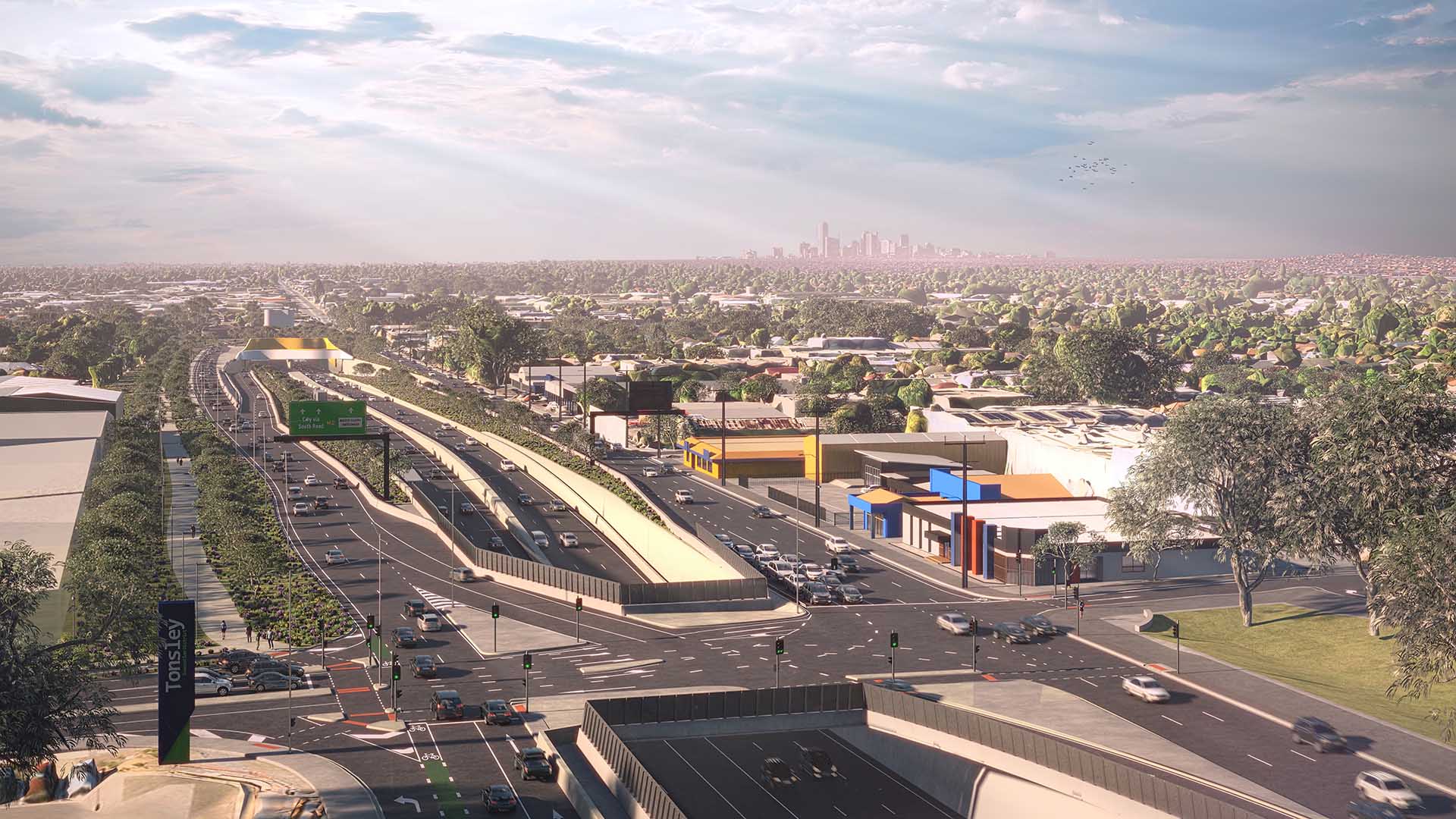 Artist's impression: Intersection of South Road and Tonsley Boulevard.
Artist's impression: Intersection of South Road and Tonsley Boulevard.
Northern package
- construction of Northern Tunnels by TBMs
- construction of cut and cover tunnels at each end of the TBM tunnels
- construction of cross passages and drainage sumps
- construction of dive structures and lowered and surface motorway
- construction of surface connections, bridgeworks and roadworks
- construction of drainage basins
- civil finishing works, including safety barriers and noise walls
- urban design and landscaping
- tunnel fit out, including safety and control systems
- construction of operational facilities including:
- tunnel ventilation facilities and outlets (if required)
- intelligent transport system infrastructure for motorway control
- water treatment plant.
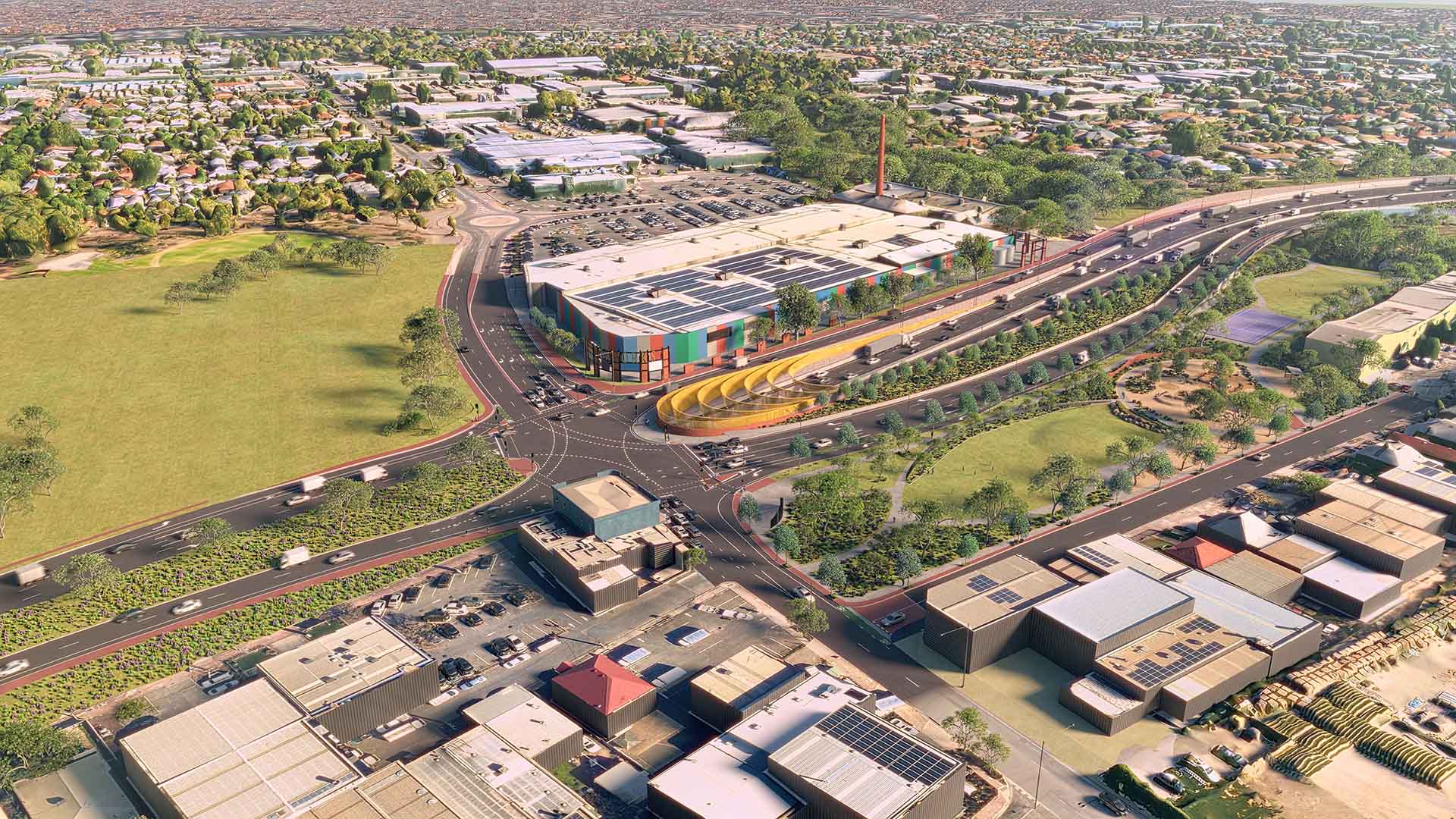 Artist's impression: Ashwin Parade intersection.
Artist's impression: Ashwin Parade intersection.
Tunnel boring machine
The project includes the construction of twin tunnels using tunnel boring machines (TBM). There will be northbound and southbound tunnels, each comprising three lanes. In addition, cross-passages will be constructed to connect the adjacent tunnels, ensuring tunnel safety and operational requirements in the event of an incident.
For more information visit Tunnel boring machine.
Video: Tunnel boring machine operation.
TBMs safely excavate and construct the tunnels as they progress through the ground, minimising disruption at surface level and limiting disturbance to the surrounding ground. Two TBMs will be required for the project and they are anticipated to be approximately 15m in diameter, longer than 100m and weigh thousands of tonnes. These machines will operate continuously, progressing approximately 8m to 10m a day. The TBMs simultaneously install the tunnel lining which is made from precast concrete segments.
Video: Tunnel lining segments.
Cross-passages connecting the tunnels will be excavated at regular spaced intervals along the tunnel alignment for maintenance, services and emergency access. These cross passages will be constructed after the TBMs have completed the tunnel lining, using specialised excavation techniques.
The tunnels will be fitted out with a range of systems to ensure safe operation for normal traffic and in the event of incidents. These include traffic management, ventilation, lighting, incident detection, communications and surveillance. Permanent operational infrastructure will also be constructed, as necessary, for ongoing management and operation of the project.
The TBMs will be shipped and delivered in smaller parts. Due to the component’s size and weight, the final stage of delivery of these components will likely be at night under escort prior to being assembled onsite. The TBMs will be assembled in a cut and cover trench.

Diagram: Example of a typical cross-passage section.
Cut and cover and trough structures
To launch the TBMs and connect the tunnels to the surface at each end, cut and cover tunnels or trough structures will be used. The cut and cover tunnel excavation method first involves the installation of retaining walls along the sides of the tunnel. The second stage is to excavate from the surface and construct the base and roof slabs which will form the tunnel.
In some cases, this can include intermediate level slabs and extra supports at the base of the structure to prevent ‘uplift’. Once the roof is in place, the surface of the cut and cover structure is either used for permanent surface roads or integrated into the wider project.
Cut and cover tunnels typically transition to open trough structures. Construction of trough structures is similar to cut and cover construction, except a roof is not installed. Portions of the open motorway are planned to be constructed in trough structures as lowered motorway. A dive structure is a type of trough structure that includes a ramp to connect below and at grade motorway sections.
Video: Cut and Cover explainer.
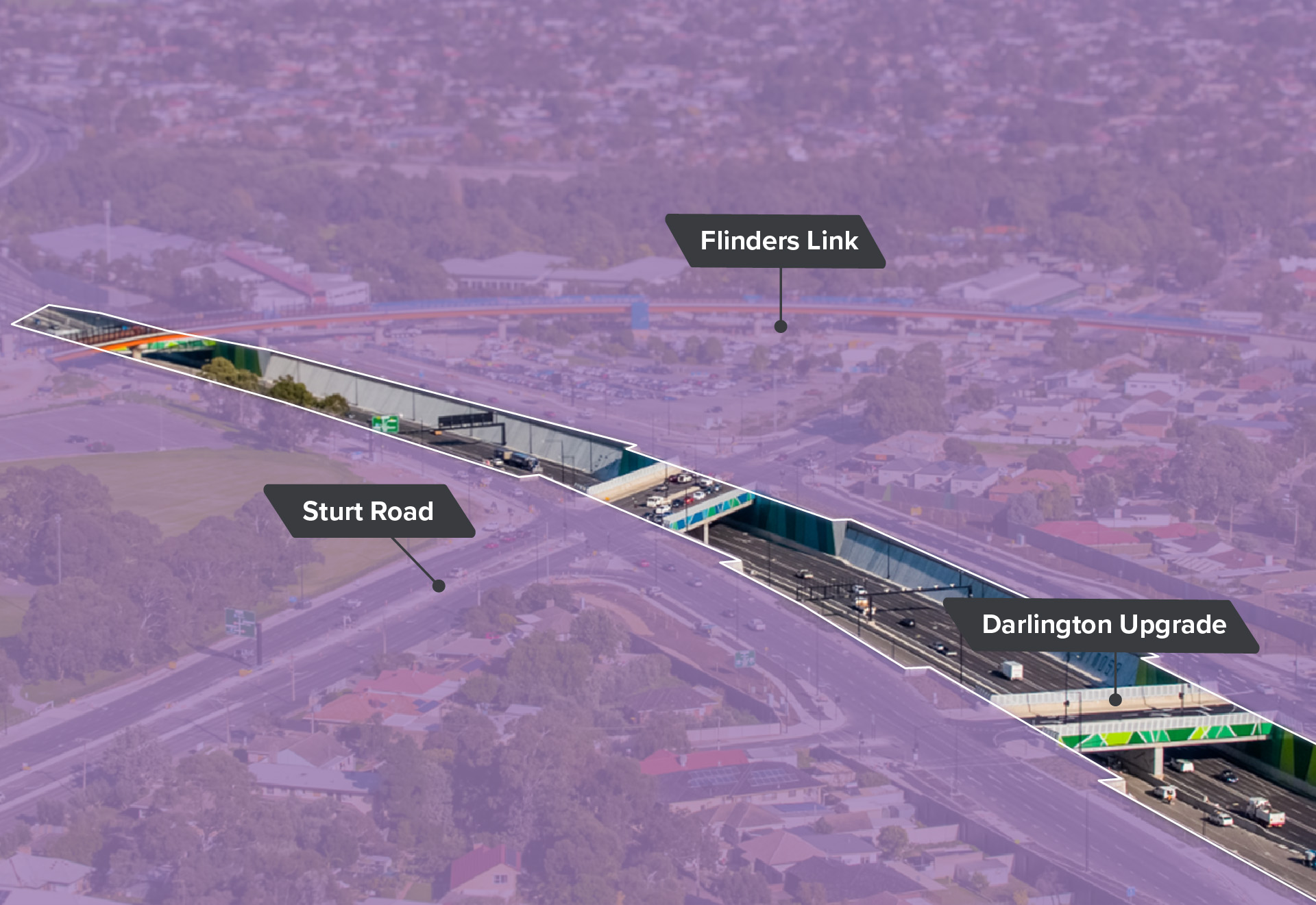
Photo: Example of a trough structure (Darlington).
Open motorway, surface roads and pavement works
Open motorway and surface roadworks are required to connect and integrate the new tunnels and motorway with the existing road network. The construction of open motorway and surface roadworks typically involves the following activities:
- major traffic staging works to enable access for the surface roadworks
- demolition of existing kerbs, structures and pavements
- utility relocation works to suit staging of open motorway and surface work
- earthworks
- bridgeworks
- construction of ramps between the open motorway and the surface road
- construction of retaining walls, noise barriers, traffic barriers and flood walls
- stormwater management including relocation of existing stormwater system
- road pavement works
- road signage and line marking
- managed motorway infrastructure
- installation and/or modification of lighting and lighting structures
- surface finishing works.
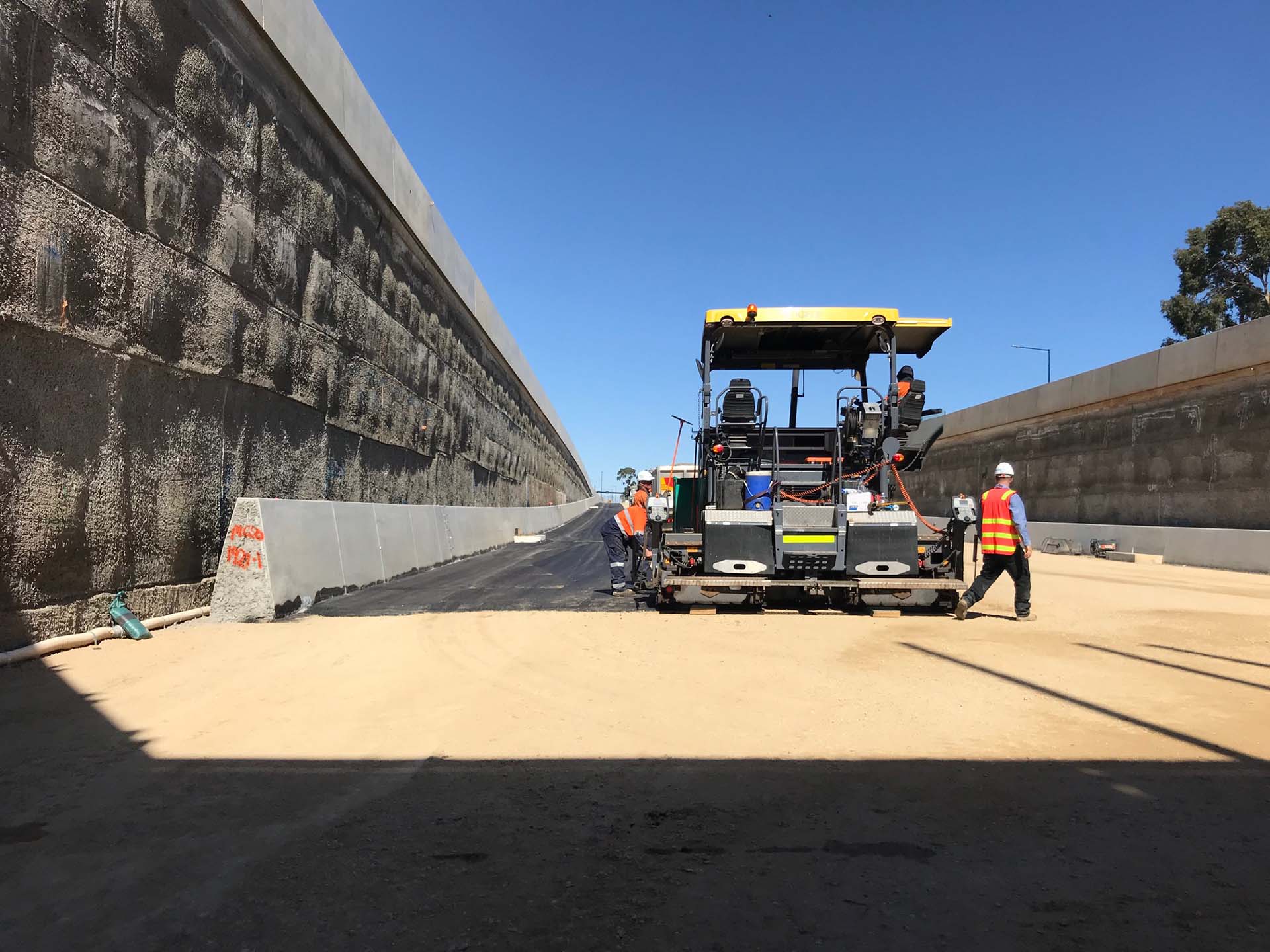 Photo: Pavement works on the Torrens to Torrens Project.
Photo: Pavement works on the Torrens to Torrens Project.Construction activities
Enabling works
Enabling works, preparatory investigations and surveys are required in advance of the main construction activities of all major infrastructure projects and are being undertaken for the T2D Project. These are works which typically take place before the Detailed Design has been finalised and include such works as:
- survey work and investigations, including investigative drilling
- condition surveys of buildings and infrastructure
- property acquisitions
- adjustment works
- installation of property fencing
- demolition of existing structures (also ongoing during main works)
- further contamination testing and land remediation, subject to the recommendations of a remediation action plan (where required)
- relocation, adjustment and protection of utilities and services impacted by the project (also ongoing during main works)
- site preparation of offsite constructing new utility services for the precast production facilities
- roadwork adjustments to provide access to temporary construction support sites
- detailed Heritage investigations, protections, salvage and/or conservation works.
Further detail regarding early works see Works in your area.
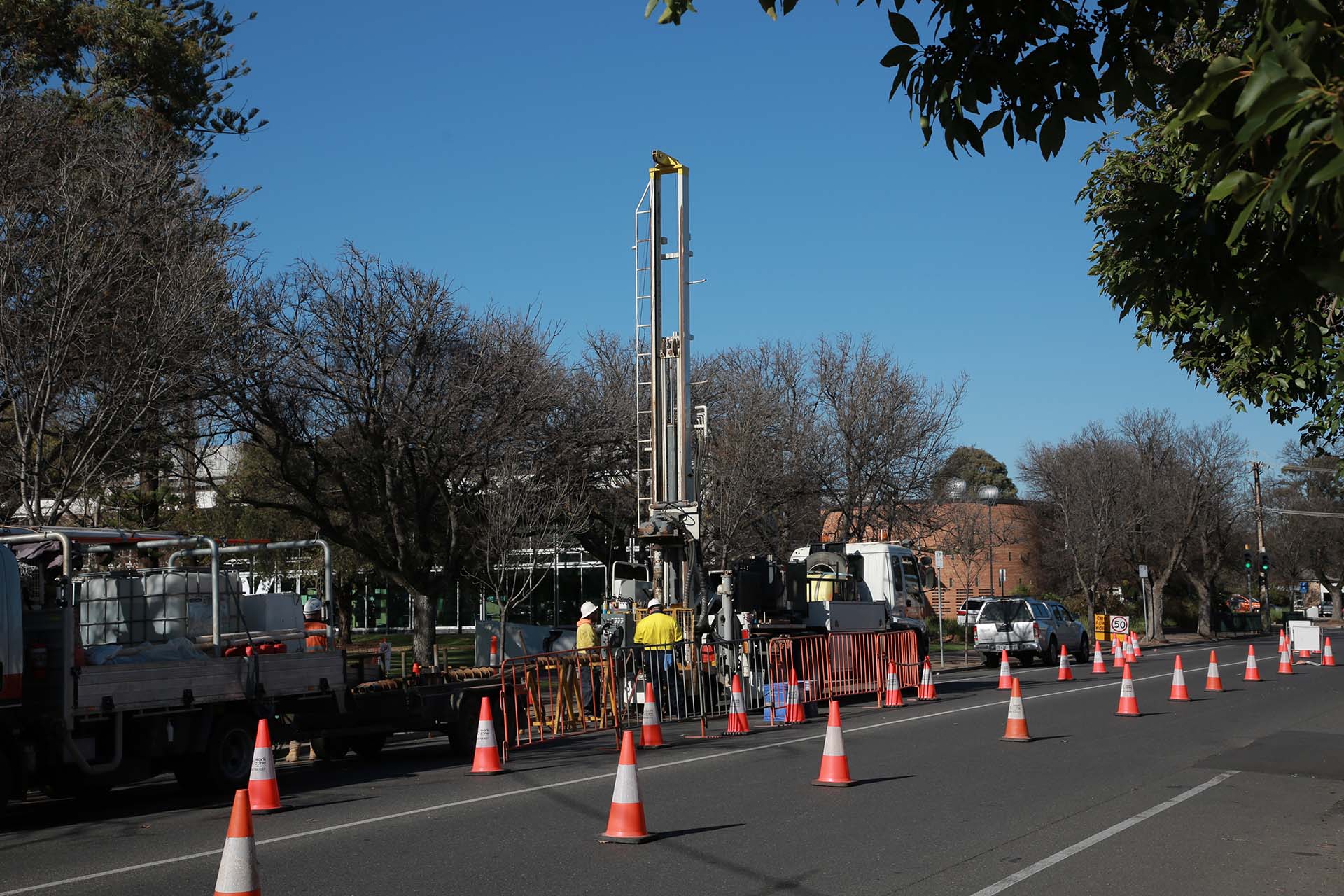 Photo: Ground investigation works undertaken for the T2D Project.
Photo: Ground investigation works undertaken for the T2D Project.
Services
Utility services will be affected within the project area and are therefore required to be relocated or protected during construction. Services affected include:
- power
- water/wastewater
- telecommunications
- gas
- other communication services.
The Department is coordinating the works with multiple service authorities and contractors to minimise impacts to surrounding communities, businesses and facilities.
Works will be managed to avoid or minimise any disruption to services. Where services are required to be relocated into local streets, resulting in a short interruption to services, residents and any others affected will be notified.
Additional power supply will be required during construction works, including high-voltage power at the tunnel support sites for the TBMs and tunnel operations. The Department is currently working with the state electricity distributor SA Power Networks to enable the necessary power supply. The Tonsley substation is currently under construction to support the Southern Tunnels TBM. A smaller substation will be built at Richmond to support the Northern Tunnels TBM.
Site establishment
Similar to enabling works, site establishment works will commence before the Detailed Design is finalised. Site establishment can include:
- demolition of existing structures and clearing of land for establishment of construction sites
- installation of environmental management controls, including site fencing, exclusion fencing for sensitive areas, noise reduction measures and erosion and sediment controls
- vegetation clearing and mulching
- traffic management controls, including changes to road signage that shows altered traffic movements and conditions
- construction of minor access roads and provision of access including potential temporary relocation of pedestrian and cycle paths and bus stops
- earthworks and installation of site facilities, storage and laydown areas for temporary construction support sites required to support underground construction works
- building structures and/or erection of demountable buildings including temporary site accesses and acoustic sheds.
Laydown areas, compounds and construction facilities
While large sections of the project works will occur underground, temporary construction support sites on the surface are needed to service construction activities including tunnelling, open motorway and surface roadworks and lowered motorway works as well as provide materials handling areas, site offices, construction storage laydown areas, parking and workforce amenities.
All temporary construction support sites will have appropriate boundary fencing. Where required, temporary noise barriers will be installed on the site boundary.
The construction sites supporting the launch and operation of the TBMs will be substantial to support the tunnelling activities across three to four years. Temporary noise-reducing acoustic sheds will be constructed near tunnel portals where the TBMs will be launched to support the 24/7 tunnelling operation and mitigate noise impacts.
Video: Southern laydown area including spoil handling.
Workforce
Construction hours
Except for underground tunnelling and associated activities, construction hours for large infrastructure projects are typically Monday to Saturday during daylight hours. Where necessary, night works and weekend works, including on Sundays, will be undertaken to reduce impacts to traffic and to minimise safety risks. These works will be managed to minimise community disturbance. Affected stakeholders will receive notifications prior to any night works starting; notifications are also available on the Department’s website, see Works in your area.
Tunnelling and required surface level supporting activities will occur up to 24-hours-a-day, seven-days-a-week. Spoil handling outside of standard construction hours will be carried out within temporary acoustic sheds to mitigate noise impacts.
To keep informed Register for project updates.
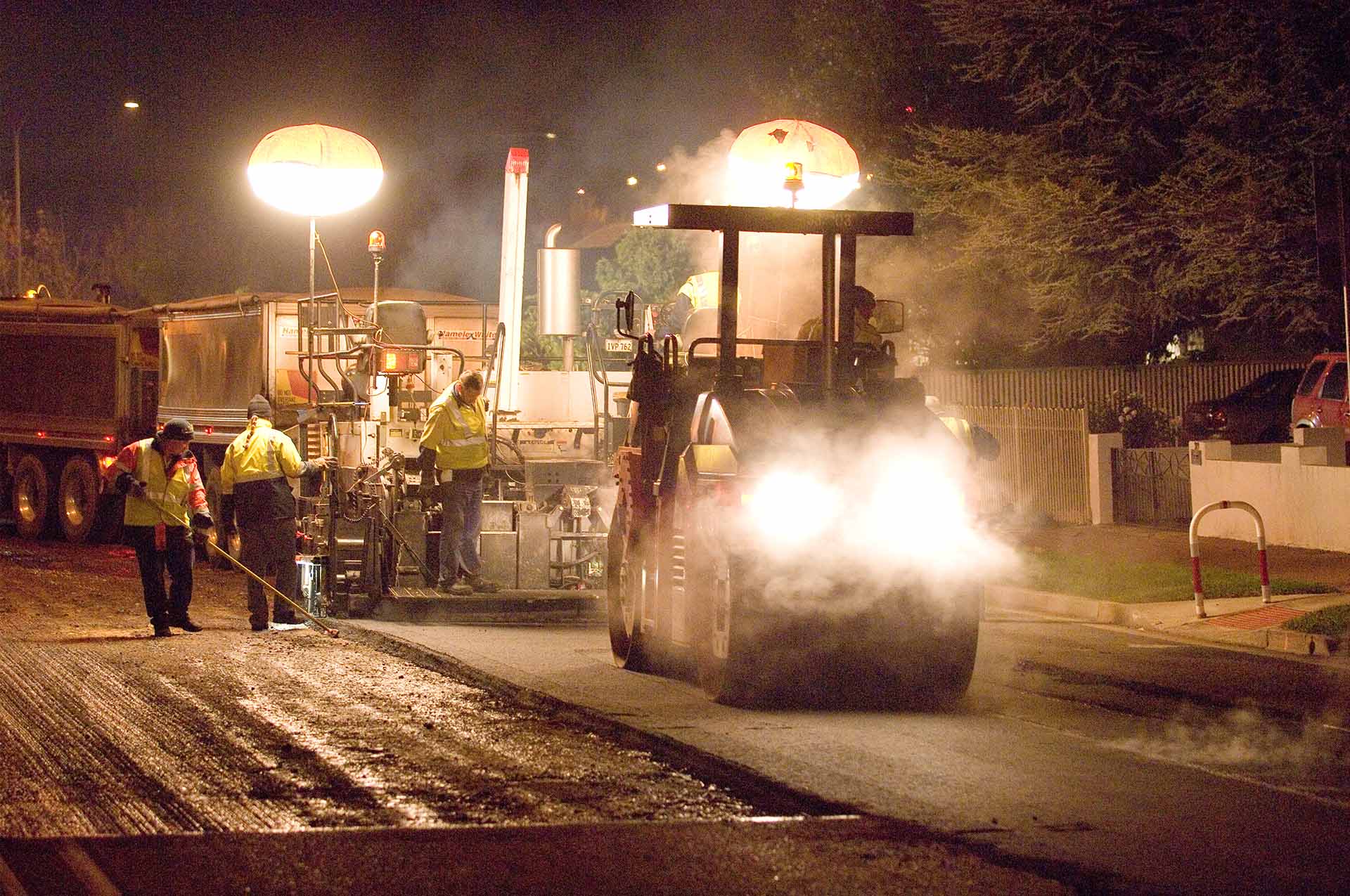 Photo: Example of night works, road resurfacing.
Photo: Example of night works, road resurfacing.
Approach
Spoil management
Tunnelling operations and the excavation of the open motorway sections will be the key generators of spoil during construction. Smaller quantities of spoil will be generated at other construction areas along the project alignment, associated with surface roadworks.
It is estimated that the project will generate more than four million cubic metres of soil, rock and fill during construction.
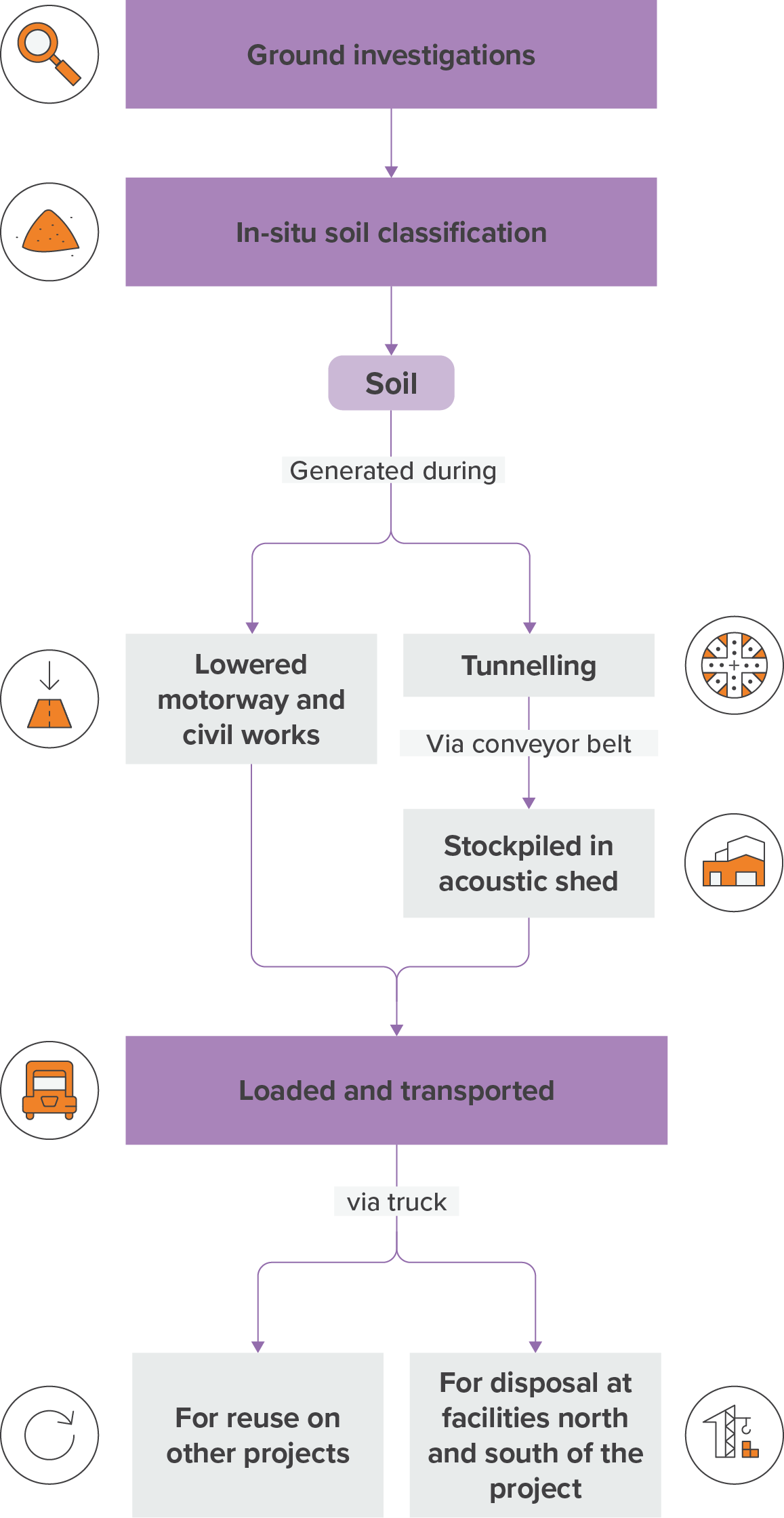
Diagram: Soil management flow chart.
There is potential to discover contaminated material during excavation works for the project. A contamination assessment has been carried out to determine the potential for encountering contaminated material during construction and detailed plans have been developed for the management and disposal of these materials in accordance with environmental regulations.
Spoil will be classified prior to leaving the construction site in accordance with SA Environment Protection Authority (EPA) standards and guidelines. For more information visit Site contamination.
Waste management
Construction of the project will generate waste streams that require management and disposal in accordance with relevant state policies and guidelines. Avoiding or minimising waste has been a key consideration for the project throughout the Project Design and development process. An authorised waste contractor will be engaged to minimise waste to landfill.
Waste streams generated during construction would include:
- demolition waste from existing structures and properties
- general construction waste such as concrete, steel and timber formwork off-cuts
- vegetation waste from clearing and grubbing
- plant and vehicle maintenance waste such as oils and lubricants
- general office waste such as paper, cardboard, plastics and food waste
- wastewater from dewatering activities
- wastewater from construction activities
- sewage waste
- spoil not suitable for re-use on the project.
Traffic management and accessibility
Construction of the project will be subject to comprehensive traffic management measures to ensure the ongoing functionality of South Road and surrounding roads and the safety of the public, motorists and construction personnel. A key approach to construction management is to minimise effects on the community and manage the project with minimal traffic changes.
Over-sized vehicles will be required for delivery and removal of large equipment on separate occasions. During construction, light and heavy vehicle movements will be required to move to and from construction sites including for deliveries, and for spoil and waste management.
The project will change the shape of the corridor in some locations, which will have an impact on traffic. Traffic switches and detours will be required to facilitate construction of the project. The community will be notified prior to any traffic conditions being changed during construction. Works will also be planned to minimise impacts on road users.
The project approach to minimise the impact to network connectivity during construction is to:
- maintain South Road as a two-lane, two-way configuration operating at 60km/h posted speed at all times where possible, and particularly during peak periods
- minimise impacts and/or disruptions to local traffic in the direct vicinity of the works and construction facilities
- maintain or relocate existing serviceability for tram and rail services crossing South Road
- maintain or relocate existing pedestrian and cyclist facilities’ serviceability
- maintain full functionality for all signalised intersections during daylight operating hours and peak periods
- maintain connectivity and functionality intersections including:
- Ashwin Parade/West Thebarton Road
- Barwell Avenue/Everard Avenue
- Pleasant Avenue/Addison Road
- Ackland Street/Raglan Avenue/Edward Street
- Celtic Avenue intersection
- Tonsley Boulevard intersection.
The following map shows the location of the six intersections listed above:
Map: Intersection connectivity
Map disclaimer
Consultation with emergency services has commenced and will continue during Detailed Design and throughout the construction phase to ensure emergency services can continue to operate effectively within the construction area.
Existing road, intersections and amenity upgrades will be undertaken to enable ongoing access, support construction works and improve safety and connectivity. Some of these works have commenced. For more information see Broader network upgrades.
Active and public transport
The project will require the temporary relocation of pedestrian and cyclist facilities and will provide alternative access arrangements around construction sites and access points. Where possible, appropriate detour routes will be established for pedestrians and cyclists by using existing cycle routes and paths that are not affected by works.
During some construction stages, changes to existing bus routes and stops may be necessary to ensure continuity of services and minimise effects on travel time, reliability and access to these services. Changes in stop locations and provision will be advertised ahead of time with changes clearly outlined for users.
See Traffic and transport for further detail.
Rehabilitation
Construction works will be planned and conducted to minimise direct impacts and avoid environmental nuisance and harm.
The project will progressively rehabilitate/remediate all areas disturbed during works. This includes all areas used for construction activities, such as compound sites, stockpile sites and access and haul roads to their original condition, unless specified otherwise in Detailed Design or in line with future agreed land use.
For further detail see Landscape and visual amenity, Site contamination, and Land use, planning and zoning.
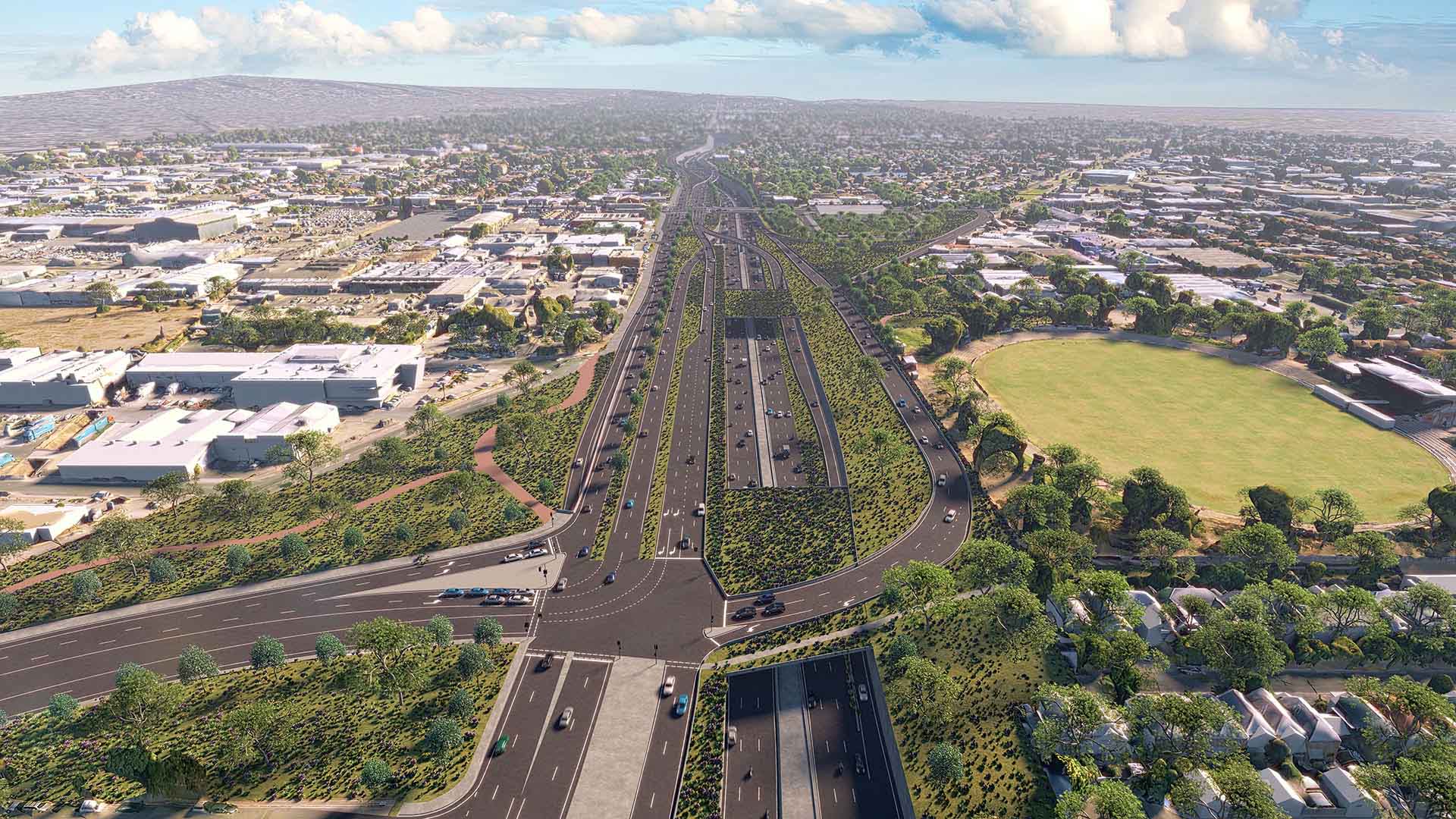 Artist's impression: James Congdon drive.
Artist's impression: James Congdon drive.
Sustainability
Infrastructure sustainability requires infrastructure to be designed, constructed and operated to optimise environmental, social and economic outcomes over the long term.
The key impact areas identified by the project include:
 Urban renewal |  Greenhouse gas emissions |  Reducing potable water use |
 Circular economy |  Social |  Climate change resilience. |
 Greening and water-sensitive urban design (WSUD) |
Details regarding sustainability on the T2D Project including the various risks, opportunities and mitigation measures have been identified and are detailed in Sustainability.
Construction environmental management plan
The construction contractor will be required to develop an environmental management system in accordance with the Australian Standards (AS/NZS ISO 14001) including a Construction environmental management plan (CEMP).
The CEMP will identify environmental risks, impacts and detail how the environmental management requirements such as environmental standards, guidelines, and regulations will be implemented and managed during project works.
Additional associated sub management plans will also be prepared and implemented such as:
- Noise and Vibration Management Plan
- Air Quality Management Plan
- Sediment, Erosion and Drainage Management Plan
- Waste Management Plan.
Compliance with the CEMP and sub plans will be monitored throughout the project with regular audits to ensure their effective implementation.
Next steps
Further development of methodology and staging information will occur during Detailed Design.
The Project Assessment Report (PAR) is currently undergoing community and stakeholder engagement process. We welcome your feedback on the PAR, see the T2D consultation page for further information.
